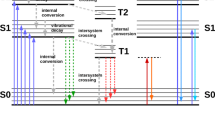Abstract
A slow, long range electron transfer (SLRET) in human serum albumin (HSA) is observed from an intact tyrosine (Tyr) residue to the neutral tryptophan (Trp) radical (Trp·) generated in pulse radiolysis. This radical is formed, at neutral pH, through oxidation with Br ·−2 radical anions of the single Trp 214 present. The SLRET rate constant of ~0.2 s−1 determined is independent of HSA concentration and radiation dose, consistent with an intra-molecular process. This is the slowest rate constant so far reported for an intra-molecular LRET. In sharp contrast with the LRET reported for other proteins, the SLRET observed here is insensitive to oxygen, suggesting that the oxidized Trp is inaccessible to—or do not react with radiolytically generated O ·−2 . In N2O-saturated solutions, the SLRET is inhibited by Cu2+ ions bound to the His 3 residue of the N-terminal group of HSA but it is partially restored in O2-saturated solutions.



Similar content being viewed by others
Abbreviations
- HSA:
-
Human serum albumin
- LRET:
-
Long range electron transfer
- SLRET:
-
Slow long range electron transfer
References
Adams GE (1973) Radiation chemical mechanisms in radiation biology. In: Burton M, Magee JL (eds) Advances in radiation chemistry, vol 3. John Wiley and Sons, New York, pp 146–159
Butler J, Land EJ, Prutz WA, Swallow AJ (1982) Charge transfer between tryptophan and tyrosine in proteins. Biochim Biophys Acta 705:150–162
Buxton GV, Stuart CR (1995) Reevaluation of the thiocyanate dosimeter for pulse radiolysis. J Chem Soc Faraday Trans 91:279–281
Davies KJ (1987) Protein damage and degradation by oxygen radicals. I. General aspects. J Biol Chem 262:9895–9901
de Vries H, Encinas S, Miranda MA, Castell JV, Beijersbergen van Henegouwen GM (1997) Photodegradation and photobinding of tiaprofenic acid: in vitro versus in vivo. Photochem Photobiol 66:432–435
Filipe P, Morlière P, Patterson LK, Hug GL, Mazière J-C, Mazière C, Freitas JP, Fernandes A, Santus R (2002a) Mechanisms of flavonoid repair reactions with amino acid radicals in models of biological systems: a pulse radiolysis study in micelles and human serum albumin. Biochim Biophys Acta 1572:150–162
Filipe P, Morlière P, Patterson LK, Hug GL, Mazière J-C, Mazière C, Freitas JP, Fernandes A, Santus R (2002b) Repair of amino acid radicals of apolipoprotein B100 of low-density lipoproteins by flavonoids. A pulse radiolysis study with quercetin and rutin. Biochemistry 41:11057–11064
Filipe P, Morlière P, Patterson LK, Hug GL, Mazière J-C, Freitas JP, Fernandes A, Santus R (2004) Oxygen-copper (II) interplay in the repair of semi-oxidized urate by quercetin bound to human serum albumin. Free Radic Res 38:295–301
Filipe P, Patterson LK, Bartels DM, Hug GL, Freitas JP, Mazière J-C, Santus R, Morlière P (2007) Albumin-bound quercetin repairs vitamin E oxidized by apolipoprotein radicals in native HDL3 and LDL. Biochemistry 46:14305–14315
Francis GA, Mendez AJ, Bierman EL, Heinecke JW (1993) Oxidative tyrosylation of high density lipoprotein by peroxidase enhances cholesterol removal from cultured fibroblasts and macrophage foam cells. Proc Natl Acad Sci USA 90:6631–6635
Grune T, Blasig IE, Sitte N, Roloff B, Haseloff R, Davies KJA (1998) Peroxynitrite increases the degradation of aconitase and other cellular proteins by proteasome. J Biol Chem 273:10857–10862
Hare PM, Price EA, Bartels DM (2008) Hydrated electron extinction coefficient. J Phys Chem A 112:6800–36802
He XM, Carter DC (1992) Atomic structure and chemistry of human serum albumin. Nature 358:209–215
Houée-Levin C, Sicard-Roselli C (2001) Radiation chemistry of proteins. In: Jonah C, Rao BM (eds) Radiation chemistry: present status and future prospects. Elsevier, New York, pp 553–584
Hug GL, Wang Y, Schoneich C, Jiang PY, Fessenden RW (1999) Multiple time scale in pulse radiolysis: applications to bromide solutions and dipeptides. Radiat Phys Chem 54:559–566
Jovanovic SV, Simic MG (1985) Repair of tryptophan radicals by antioxidants. J Free Radic Biol Med 1:125–129
Kragh-Hansen U (1981) Molecular aspects of ligand binding to serum albumin. Pharmacol Rev 33:17–53
La Verne JA, Pimblott SM (1991) Scavenger and time dependence of radicals and molecular products in the radiolysis of water: examination of experiments and models. J Phys Chem 95:3196–3206
Lee H, Faraggi M, Klapper MH (1992) Long range electron transfer along an alpha-helix. Biochim Biophys Acta 1159:286–294
Minnihan EC, Seyedsayamdost MR, Stubbe J (2009) Use of 3-aminotyrosine to examine the pathway dependence of radical propagation in Escherichia coli ribonucleotide reductase. Biochemistry 48:12125–12132
Neta P, Huie RE, Ross AB (1990) Rate constants for reactions of peroxyl radicals in fluid solutions. J Phys Chem Ref Data 19:413–513
Patterson LK, Lilie JA (1974) Computer-controlled pulse radiolysis system. Int J Radiat Phys Chem 6:129–141
Redpath JL, Santus R, Ovadia J, Grossweiner LI (1975) The oxidation of tryptophan by radical anions. Int J Radiat Biol 27:201–204
Santus R, Patterson LK, Hug GL, Bazin M, Mazière J-C, Morlière P (2000) Interactions of superoxide anion with enzyme radicals: kinetics of reaction with lysosyme tryptophan radicals and corresponding effects on tyrosine electron transfer. Free Radic Res 33:383–391
Sengupta S, Wehbe C, Majors AK, Ketterer ME, DiBello PM, Jacobsen DW (2001) Relative roles of albumin and ceruloplasmin in the formation of homocystine, homocysteine-cysteine-mixed disulfide, and cystine in circulation. J Biol Chem 276:46896–46904
Weinstein M, Alfassi ZB, Defelippis MR, Klapper MH, Faraggi M (1991) Long range electron transfer between tyrosine and tryptophan in hen egg-white lysozyme. Biochim Biophys Acta 1076:173–178
Yamashoji S, Yoshida H, Kajimoto G (1977) Prooxidative effects of Cu2+-amino acid complexes on the autooxidation of linoleic acid. Agric Biol Chem 41:1947–1951
Acknowledgments
This is Document No. NDLR-4892 from the Notre Dame Radiation Laboratory which is supported by the Office of Basic Energy Sciences at the United States Department of Energy.
Author information
Authors and Affiliations
Corresponding author
Rights and permissions
About this article
Cite this article
Patterson, L.K., Mazière, JC., Bartels, D.M. et al. Evidence for a slow and oxygen-insensitive intra-molecular long range electron transfer from tyrosine residues to the semi-oxidized tryptophan 214 in human serum albumin: its inhibition by bound copper (II). Amino Acids 42, 1269–1275 (2012). https://doi.org/10.1007/s00726-010-0819-5
Received:
Accepted:
Published:
Issue Date:
DOI: https://doi.org/10.1007/s00726-010-0819-5




